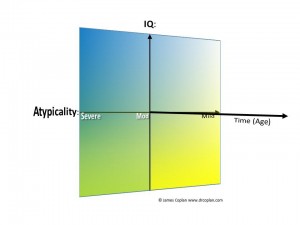Beyond Kanner and Asperger, Part 6: ASD in 3D
Dr. Coplan introduces his 3D model encompassing ASD, IQ, and Time (Age).
In the preceding posts, I have dealt with the first 5 items in my list of basic principles:
-
Atypicality exists in various degrees, from profound to minimal.
-
There is no clear boundary between atypical and “normal.” Rather, atypical traits are distributed throughout the entire population.
-
General Intelligence (IQ) is a separate property from atypicality.
-
Atypicality of any degree can co-exist with any level of general intelligence.
-
At any given age, the clinical picture is determined by the joint impact of the degree of atypicality and the level of general intelligence.
Now it’s time to take on the last two:
-
Atypicality has a natural history of improvement over time, irrespective of treatment.
-
Long-term outcome is primarily determined by the joint impact of the degree of atypicality and level of general intelligence. The higher the IQ, the faster and more completely atypicality fades, as time passes.
Last time [Link] we developed an XY graph that captures the simultaneous impact of degree of atypicality, and level of general intelligence, on clinical presentation (“High Functioning Autism,” “Low Functioning Autism,” “Asperger Syndrome,” and borderland diagnoses such as Nonverbal Learning Disability). This 2-dimensional graph is useful up to a point, but it still represents the individual’s appearance at one point in time. But we have known since Leo Kanner’s landmark paper on autism that children with autism improve over time, even without treatment:
“Between the ages of 5 and 6 years,” Kanner wrote, “they gradually abandon echolalia and learn spontaneously to use personal pronouns…. Language becomes more communicative, at first in the sense of a question-and-answer exercise, and then in the sense of greater spontaneity of sentence formation….Noises and motions are tolerated more than previously. The panic tantrums subside. The repetitiousness assumes the form of obsessive preoccupations…the children begin to play in a group, still never with the other members of the group, but at least on the periphery alongside the group [Emphasis in the original]… All of this makes the family feel that, in spite of recognized ‘difference’ from other children, there is progress and improvement.”
500 years ago, Copernicus faced the challenge of describing a universe in which the earth was no longer the stationary center, but a planet moving through space. We face the same challenge. Like the earth, ASD is a moving target. How do we capture this in our model of the “developmental universe”?
Consider a loaf of sliced bread. Each slice represents a successive position in the loaf. In a similar fashion, we can stack a series of XY graphs into a “loaf.” Rather than marking a physical location, however, each individual XY graph represents a successive slice of time:
Figure: A stack of XY graphs, similar to loaf of sliced bread; each “slice” (XY graph) represents a successive moment in time.
Watch video animation here.
Rather than showing each individual slice, the conventional way to display three variables is to add a third axis: Time (Age). This is designated the “Z” axis.
Figure: Three-dimensional XYZ graph capturing degree of atypicality, IQ, and Time (Age).
Now that we have our basic model, what can we do with it? Quite a bit, as it turns out.
More next time.
James Coplan, MD is an Internationally recognized clinician, author, and public speaker in the fields of early child development, early language development and autistic spectrum disorders. Join Dr. Coplan on Facebook and Twitter. Have a question for Dr. Coplan? Ask the doctor.
















Leave a Reply